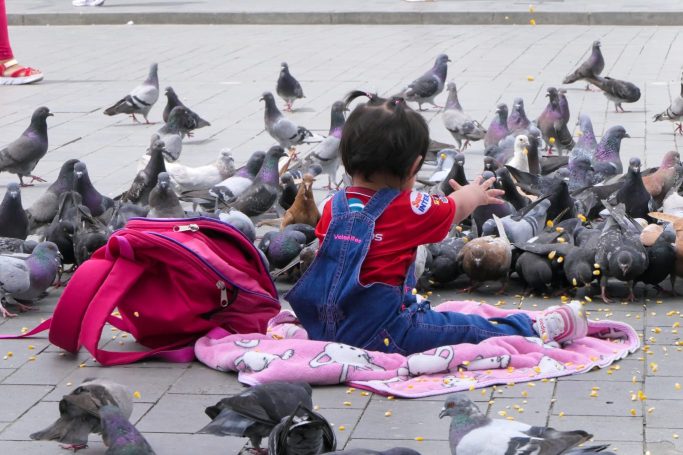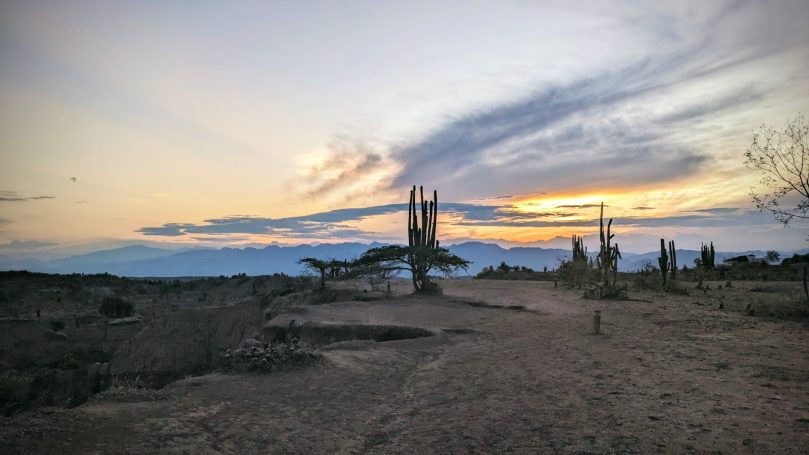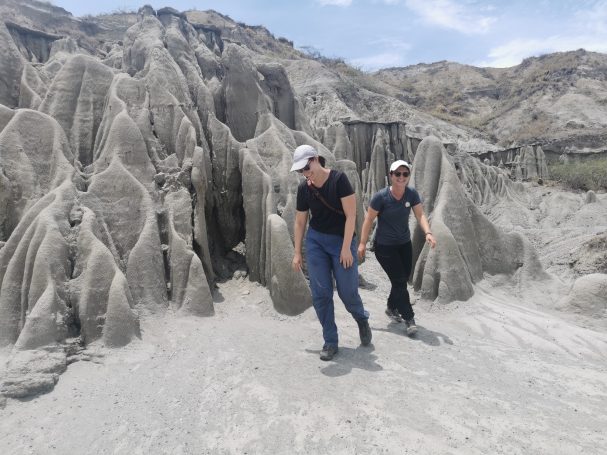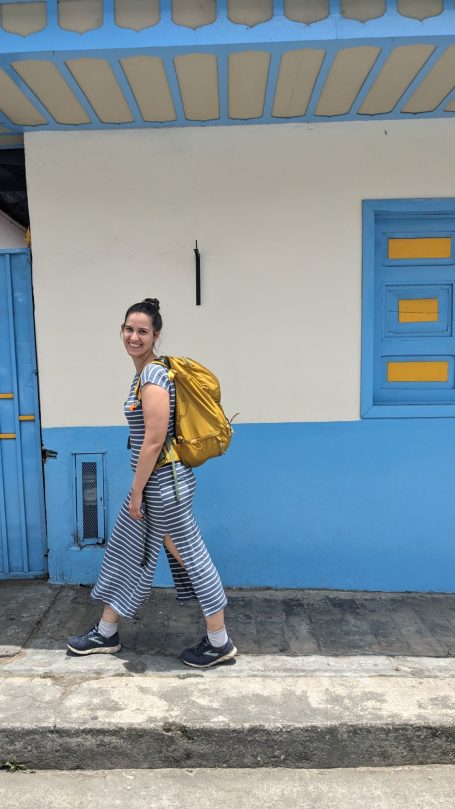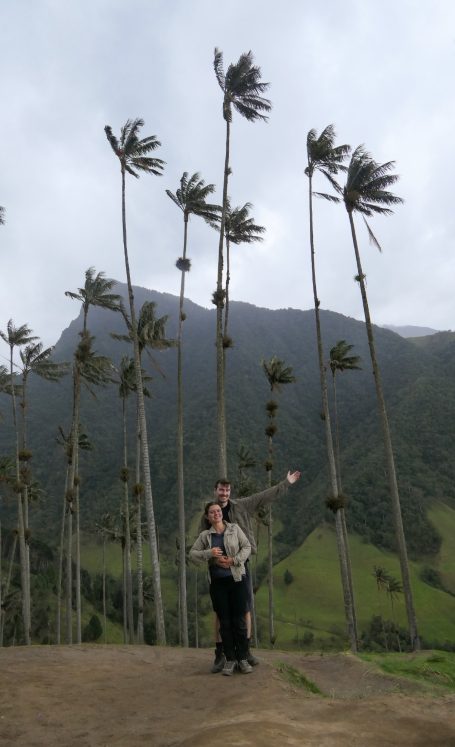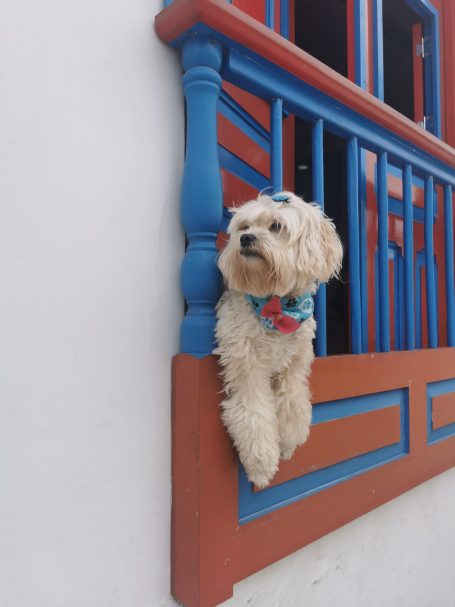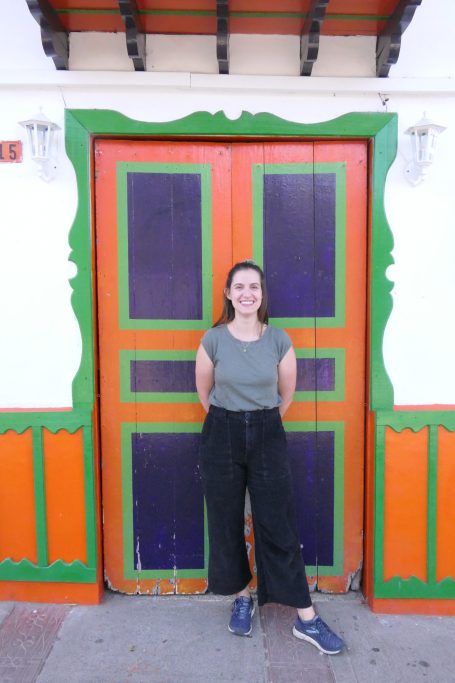Colombia caliente
***Deutsche Version***
Colombia caliente—where not only the sun but also the dance moves and emotions run at full speed.
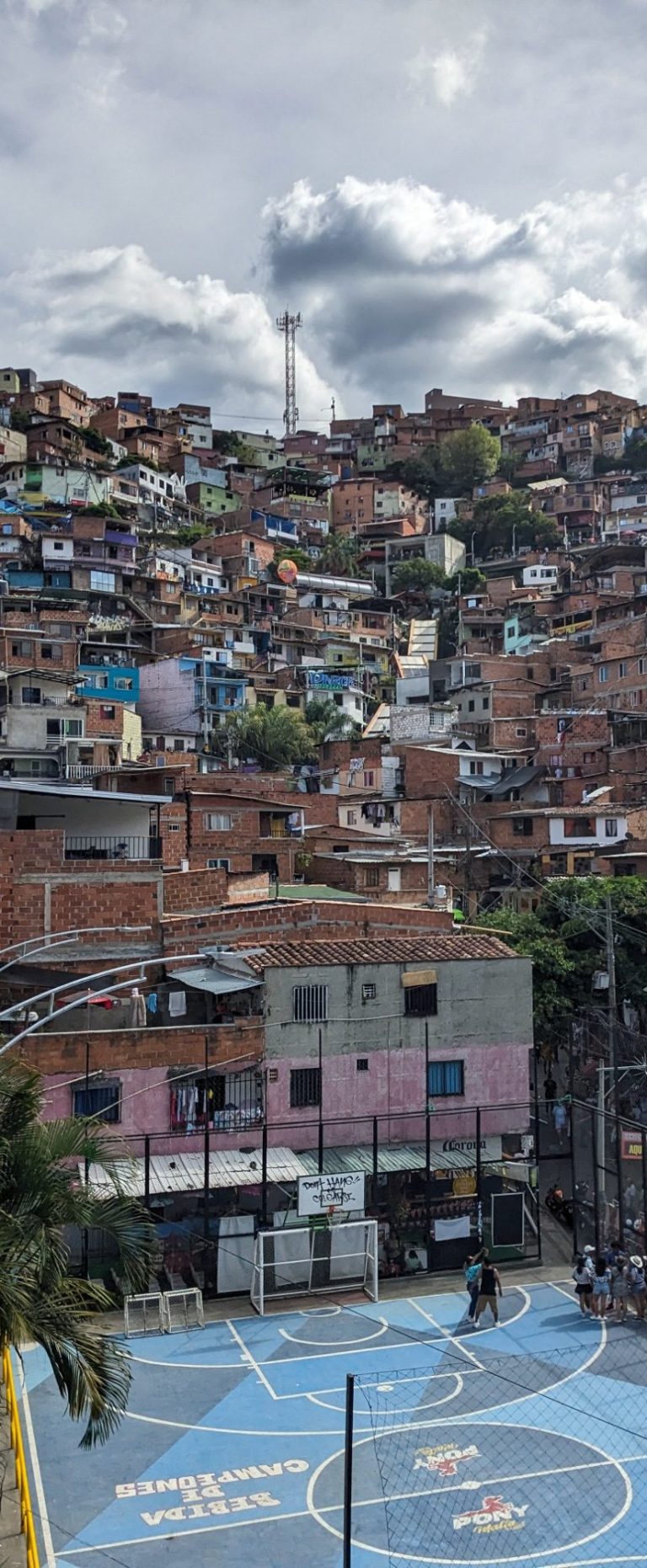
Southern Colombia—emotions and sleepless nights
Our journey to Colombia began with a bus journey from Ecuador to Popayán. It was peppered with chaotic taxi journeys and memorable breaks. After a tasteless cold meal in a shed at the bus station, Dominik made it clear once again what his food philosophy is: “He doesn’t eat just to have eaten, but to enjoy it.”
After all, we experienced a gastronomic highlight in a cosy Italian restaurant in Popayán. Between posters of the Montreux Jazz Festival (yes, you read that right), we were served a culinary delight. The aroma of pasta and pizza filled the air, and we could only laugh about the tense discussion from lunchtime.
We were already impressed by Popayán at night, so we decided not to leave immediately the next day but to take our time to explore the city. The journey had been arduous, and we looked forward to sleeping a little longer the following day. Colombia and sleeping longer? Not such an easy endeavour as we were to find out. At 5.30 in the morning, we were abruptly woken up. Our room neighbour decided to give a private R&B concert. His off-key singing sounded like he was singing at full volume in our room.

After 45 minutes, Jana’s somewhat South American temperament got the better of her, and she vigorously knocked on his door and told him off in Spanish. The young man was so taken aback that she was almost sorry afterwards. Rumour has it that the guy wasn’t a hostel guest but the receptionist. Unfortunately, Jana couldn’t remember his face when she was half asleep, but it would have been easy to tell from his reaction when we checked out that morning. So, the day started very early again. We went for breakfast and later explored the white city on a walking tour. Apart from a few essential buildings, the whole town is entirely white and really impressed us. In addition to beautiful architecture, there are many cultural events, art and various culinary delights to enjoy.
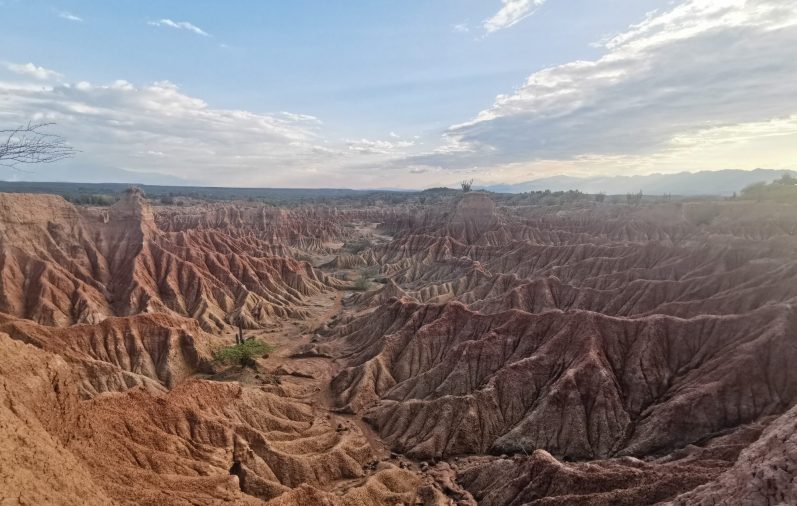
The journey continued to Neiva. The bumpy roads took us through dizzying mountain landscapes, and it took us just under nine hours to cover the 270 kilometres. Also, the second night in Colombia could have been more restful. The incredible heat was so oppressive that the fan whirring at full speed was barely enough to provide the slightest cooling.
We set off on our two-day tour through the Tatacoa Desert the next day. Strictly speaking, the Tatacoa Desert is not a desert but a dry forest with different zones. One part is called the Red Desert. The contrasts between the red eroded earth, the green cacti and the blue sky were stunning. During the night, we also had a breathtaking view of the starry sky.
Once again, sleep was in short supply. This time, we weren’t woken up by an amateur singer or the heat but by a screaming child. It kept screaming “Mummy” and “Daddy” for an hour in the morning. According to Vera, the name “Jana” was also occasionally mentioned. There was almost another outburst, but the motivation to leave the tent was too low in the drowsy state. At breakfast, we fussed about what a pain in the arse the child was. Suddenly, “Närvesägi” (the $wiss word for an annoying person) rang out above our heads in almost perfect Swiss German. We all realised at the same time that it wasn’t a child screaming like a spitfire but a cheeky parrot that imitated us. We all had to laugh. A child would not have been screaming so regularly to the beat and had the stamina for a whole hour.

In pleasant temperatures—although pleasant is actually the wrong word at over 30ºC—we hiked through a canyon in the morning and passed impressive rock formations in the Grey Desert. After a siesta and a dip in a pool, we made our way back, where an absolute highlight awaited us: an air-conditioned room. We sipped an ice-cold beer in bed and let the cool breeze from the air conditioning purr us. There was nothing better after this heat!
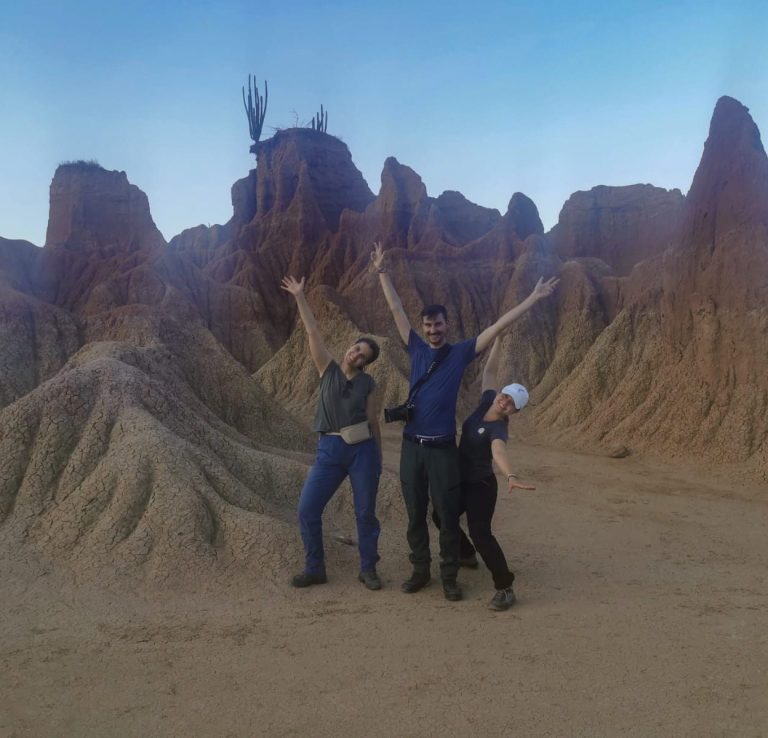
Salento and the love of coffee
In the middle of Colombia’s lush mountain landscape lies Salento, a picturesque little town that took our hearts by storm. Here, colonial architecture, colourful houses and the aroma of freshly brewed coffee merge into an unforgettable panorama.
In the final days of our adventures as DJV on Tour, we ventured out on beautiful hikes around Salento, marvelled at the impressive wax palms and let our minds wander. But the real highlight was a coffee tour that introduced us to the secrets of coffee production. From picking the coffee cherries to the perfect roast, we experienced the love and dedication that goes into every cup of this precious beverage.
But amid this picturesque paradise, a melancholy crept in—saying goodbye to Vera. Our hearts were heavy when we had to separate from our travelling companion. The thought of the adventures to come without her felt unfamiliar.
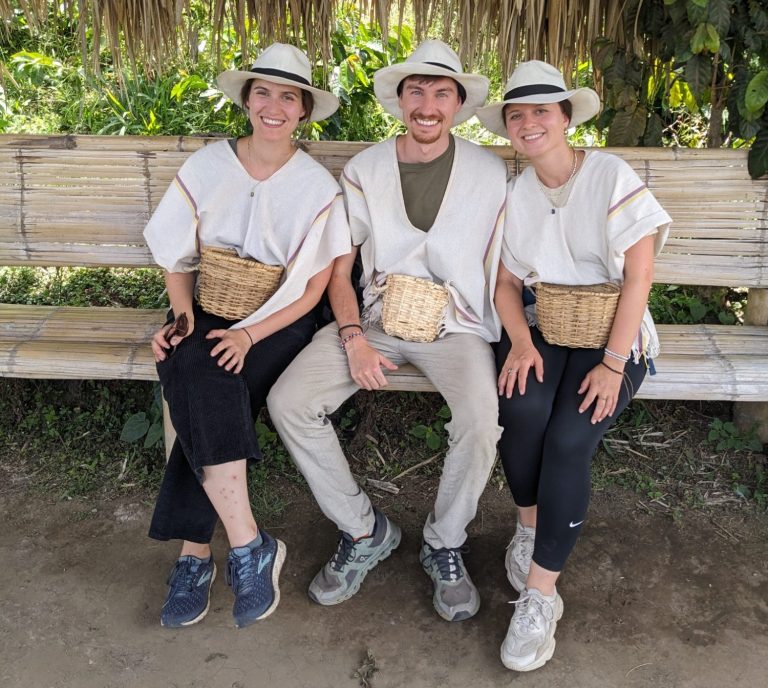
The Caribbean coast in the hot north
We thought we had left the heat behind us after the Tatacoa Desert, but Colombia’s Caribbean coast around Santa Marta and the Tayrona National Park made us sweat again. This post is not called “Colombia caliente” for no reason.
After a few relaxing days in a beautiful open bamboo hut in the middle of the jungle, we set off for the famous Tayrona National Park—a tropical paradise that enchanted us. After about an hour’s hike through the jungle, we reached Caribbean dream beaches with white sand and countless palm trees that invited us to linger. For the next night, we booked a hammock at one of the campsites right by the sea. The night in the hammock was undoubtedly an experience, even if it wasn’t ideal for our backs. Instead, we were greeted with sunshine and empty beaches the following day.

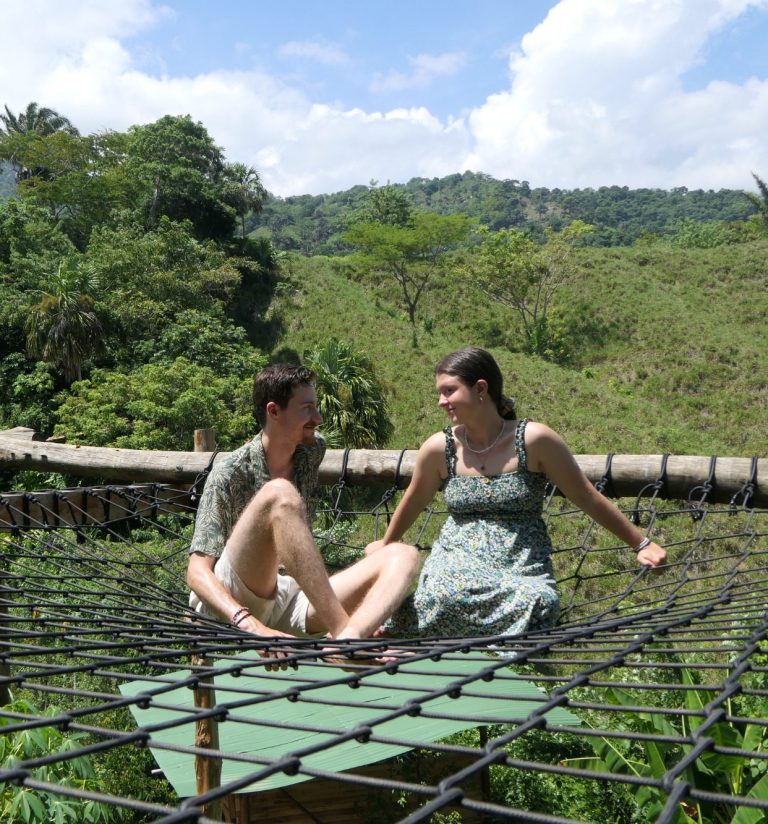
After a short detour to Minca, we travelled from Tayrona National Park to Cartagena, a city that impresses not only with its colonial beauty but also with its Colombian joie de vivre. When we plunged into the hustle and bustle on our first evening, we were overwhelmed by the electrifying atmosphere. Small pop-up bars were installed on every corner, encouraging people to dance with their exaggeratedly large jukeboxes and Latin beats. To the right and left of the alleyways were small tables with plastic chairs everywhere, and the range of drinks on offer was immeasurable. How the breakdance crews managed to perform in the narrow alleyways with all the makeshift bars, including acrobatic performances, is still a mystery to us. In the morning, everything had disappeared as if it had never taken place before being set up again later that afternoon.
Throughout the city, you also came across rap artists who spontaneously create personalised songs for you. Dominik is still proud of his title, “Dominik the Boss”, which was created for him by one of them. In Cartagena, the historical backdrop merges with the pulsating rhythm of street music, and we let ourselves be carried away by its atmosphere.
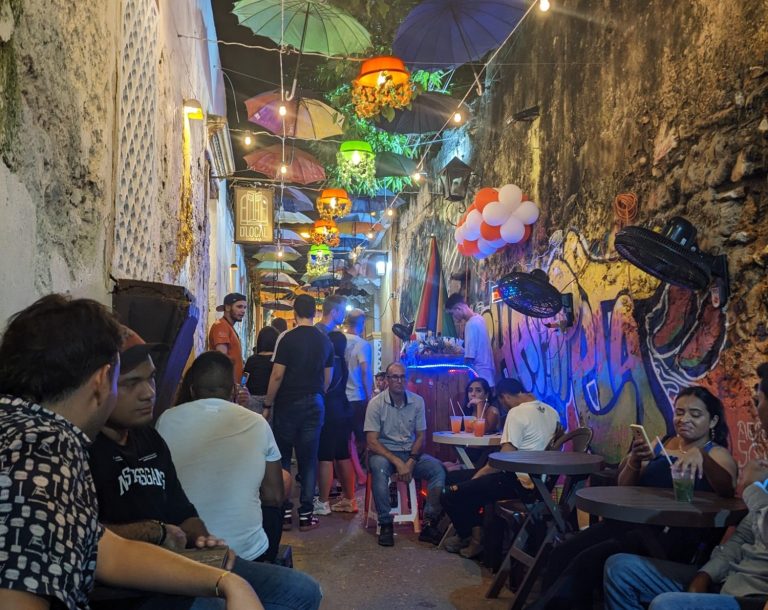
Based on various recommendations, we booked two nights on the Rosario Islands, which are only an hour’s boat ride from the harbour in Cartagena. Unfortunately, the weather didn’t play along during these days, and our snorkelling tour and our visit to the glowing plankton fell through. We have never experienced such a thunderstorm in our lives. It happened directly above our heads, and the lightning struck in the immediate vicinity. The thunder was so loud that you almost had to cover your ears. Tragically, a fisherwoman was even killed, as we learned later.
The following day was no different. The sea was so rough and stormy that we could hardly imagine getting back to the mainland. Fortunately, the weather improved a little in the afternoon, and we had a window of opportunity to start our return journey. We left the islands with mixed feelings, as we also had the impression that the care for nature could be better there. Fortunately, we had a few beach days before this trip and caught our night bus in good time—our last (!) in South America.
Green oases, street and coffee art
From the hot Caribbean coast, we travelled to Medellín, the city of eternal spring. Medellín greeted us with pulsating energy and green splendour, and nowhere else were there so many cafés that made our hearts sing.
Amidst the urban beauty, one neighbourhood in particular stood out—Comuna 13 San Javier on the steep slopes west of the city. Once plagued by violence and insecurity, the “comuna” has undergone a fascinating transformation. After the death of drug baron Pablo Escobar, various guerrilla groups attempted to gain control. The neighbourhood was highly significant for the drug and arms trade due to its access road to the city. After years of fighting between guerrilla and paramilitary groups, the government carried out two devastating bombings in 2002 to put an end to what used to be the most dangerous neighbourhood in the world.


As Comuna 13 was one of the most densely built-up neighbourhoods in the city, countless buildings were razed to the ground, and many civilians were killed in this bombing. This past is brought to life by every graffiti on the walls, showing the impressive cohesion and resistance of the community.
The escalators on the slopes were a gift from the city to give hope back to the destroyed comuna. They are not only an architectural wonder but also a symbol of social progress. They make it easier for residents to access education and job opportunities.
The visual celebration was accompanied by hip-hop dances by local talents who expressed history through rhythm. Overcoming the past was celebrated loudly and cheerfully and broadcast to the world. The thought that 20 years ago, this place was one of the most dangerous places in the world was almost unimaginable and gave us hope that change for the better is possible after all.
With its pleasant temperatures, Medellín was also the perfect place to deepen our love of “Arte Latte”. Inspired by the impressive creations of the baristas, who even conjured up llamas and seahorses on the surface of the coffee, Jana had the glorious idea of attending a four-day barista course. Not only did we learn the secrets of the “Arte Latte”, but we also deepened our understanding of different coffee preparation methods.
We had a rigorous teacher who emphasised cleanliness and precision. For the first time since we left in April, everything had to be done to the gram, in the correct order and with the proper technique. We missed these clear structures and care a little.
We can at least partially reassure anyone who thinks we experienced a total caffeine flash during these days. We practised with coloured and soapy water and only prepared two coffees with “Arte Latte” at the end of the lesson—but we still drank a lot of coffee. We still can’t conjure up llamas or seahorses on our cappuccinos, but we did manage to make a tulip in the end. Maybe this trip will allow us to hone our skills even further.

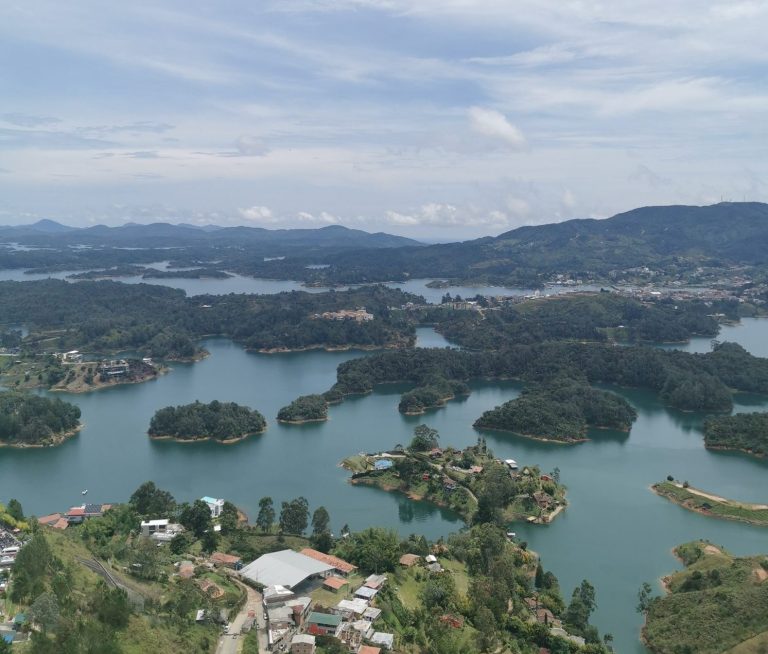
After four days in lively Medellín, we took a detour to Guatapé at the weekend—a village with a very unique charm. What makes Guatapé special is not just the narrow streets and the colourful zocalos on the houses but, above all, the famous rock of Guatapé. This imposing monolith can be climbed via a staircase. It is not only an impressive natural wonder but also offers a great panoramic view of the artificial reservoir and the surrounding landscape.
Back in Medellín, we completed our last lessons of the barista course before proudly receiving our certificate. As a kind of reward, we could spend the next three days in the holiday home of one of Jana’s former work colleagues in Sopetrán. We were totally overwhelmed by the hospitality of his family. After we were warmly welcomed at their home in Medellín, the uncle personally took us to the holiday home and showed us around. In the following days, we were well looked after, and we cannot thank Pablo and his family enough for making our last days in South America so unique.
While in the holiday home, we experienced something that can only happen in South America that we don’t want to withhold from you. We unintentionally booked a flight for 5 a.m. instead of 5 p.m. As with almost everything in South America, we were saved by contacting the airline via WhatsApp. Although they initially said that the flight would not be suggested in the system, it suddenly worked after a somewhat more straightforward complaint. We had already agreed to the surcharge of CHF 40 when the agent said we could rebook the flight for free if we wrote a letter. We followed the bizarre advice and wrote a two-liner on a notepad saying we had made a mistake when booking. Together with a photo of our passport, we sent the letter via WhatsApp and were able to rebook the flight free of charge. The strange procedure took about three hours, but we will probably always remember it.
Bogotá and the rip-off at the end
Bogotá was the starting point for our onward journey. Many people didn’t recommend the city, but we still wanted to give the capital at least a chance. It exuded an utterly different flair to the rest of Colombia we visited. The city is located high in the Andes, the weather is correspondingly cooler, and it rains every day between 1 and 2 p.m. The city tour was one of the best we have been on in six months, and Bogotá revealed very charming and trendy neighbourhoods. However, it is still not one of our favourite cities in South America.
On the last day, we were unfortunately scammed by a taxi driver with fake money. Once again, we realised that neither of us can think clearly when hungry. That will be a lesson for us in the future. We have sworn never again to get into a taxi with someone when our gut feeling isn’t right from the start. This incident only marred our conclusion of the epic chapter “Colombia caliente” for a brief moment. Despite the many stories about possible dangers in Colombia, we never felt unsafe. However, peace is still very recent, and it is therefore understandable that Colombia is still associated with violence in many people’s minds. The 2016 peace agreement between the Colombian government and the FARC (Revolutionary Armed Forces of Colombia) marked a historic milestone. Our trip through Colombia was imbued with the warmth of the country and the passion of its people. The country has quickly become one of our absolute favourites.

To live up to our name DJ on Tour, here is a song that accompanied us during this time. Enjoy the Colombian vibes.
Gallery
Wir benötigen Ihre Zustimmung zum Laden der Übersetzungen
Wir nutzen einen Drittanbieter-Service, um den Inhalt der Website zu übersetzen, der möglicherweise Daten über Ihre Aktivitäten sammelt. Bitte überprüfen Sie die Details in der Datenschutzerklärung und akzeptieren Sie den Dienst, um die Übersetzungen zu sehen.

